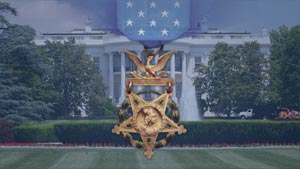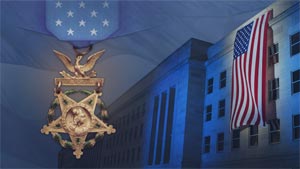MEDAL OF HONOR
Vietnam WarSpecialist Fourth Class Kenneth J. David

hometown
Girard, Ohio
Enlistment date
August 1969
Military Occupation (MOS)
Indirect Fire Crewman (11C)
Unit
Company D, 1st Battalion, 506th Infantry Regiment, 101st Airborne Division
Deployments
Vietnam War, 1970
Kenneth J. David was born on Jan. 21, 1950, and grew up in Girard, Ohio. Active in the Boy Scouts, he earned the prestigious achievement of Eagle Scout.
He was drafted and entered the Army in August of 1969 and received basic training at Fort Campbell, Kentucky, then advanced training at Fort Polk, Louisiana.
 Then-Pvt. 2nd Class Kenneth David in his dress uniform, 1970, before his deployment to Vietnam. Courtesy photo.
Then-Pvt. 2nd Class Kenneth David in his dress uniform, 1970, before his deployment to Vietnam. Courtesy photo.
He was sent to the Republic of South Vietnam in January 1970, and on May 7, 1970, after being wounded, he was moved to Valley Forge General Hospital in Pennsylvania. For his actions during a military operation from "Abandoned Fire Support Base Maureen" in the northern part of the Republic of South Vietnam, David was presented with the nation’s second highest award for extraordinary heroism, the Distinguished Service Cross, while serving as a radio-telephone operator with the 101st Airborne Division.
He retired from York Mahoning Mechanical in Youngstown and was inducted into the Ohio Military Hall of Fame for Valor and Military Bravery on May 7, 2010 – 40 years after he was wounded in Vietnam. He was also inducted as a Distinguished Member of the Regiment of the 1-506th Infantry Regiment, 101st Airborne Division (Air Assault), at Fort Campbell.
He has two sons, Kevin and Brian.
He is a member of the Disabled American Veterans, VFW Post 3767, the 101st Airborne Division Association, the 506th Airborne Infantry Regiment Association Legion of Valor, Army-Navy Garrison #252, the Ripcord Association, Vietnam Veterans of America, and Masonic Lodge #529 as a master mason.
His awards include the Distinguished Service Cross, the Purple Heart with 1st Oak Leaf Cluster, Air Medal, the Good Conduct Medal, the National Defense Medal, the Vietnam Campaign Medal, the Vietnam Service Medal with two Bronze Stars, the Combat Infantry Badge, the Republic of Vietnam Civil Actions Honor Medal, the First Class Unit Citation Badge, the Republic of Vietnam Gallantry Cross with Palm Unit Citation Badge, Expert Marksmanship Badge.
 Kenneth David bids farewell to his brothers in arms of D Company at the Vietnam War Memorial in Washington, D.C. Courtesy photo.
Kenneth David bids farewell to his brothers in arms of D Company at the Vietnam War Memorial in Washington, D.C. Courtesy photo.
The Battle
Fiercely defending his team.
May 7, 1970 | Thua Thien Province, Republic of Vietnam

101st Airborne Division
Insignia of the 101st Airborne Division, featuring "Old Abe," the division's mascot and the word "AIRBORNE." Read Full Unit History
Then-Pfc. Kenneth J. David distinguished himself by acts of gallantry and intrepidity above and beyond the call of duty on May 7, 1970, while serving as a radio-telephone operator with Company D, 1st Battalion, 506th Infantry, 101st Airborne Division, near Fire Support Base Maureen, Thua Thien Province, Republic of Vietnam.
On this date, David's company came under an intense attack from a large hostile force. The enemy’s ferocious initial assault mortally wounded the company’s platoon leader and resulted in numerous other friendly casualties. Upon the initial assault and without hesitation, David handed his radio to his platoon sergeant and moved forward to the defensive perimeter, unleashing a barrage of automatic weapons fire on the enemy. From this location, David bitterly resisted all enemy efforts to overrun his position. Realizing the impact of the enemy assault on the wounded, who were being brought to the center of the perimeter, David – without regard for his own life – moved to a position outside of the perimeter while continuing to engage the enemy.
Each time the enemy attempted to concentrate its fire on the wounded inside the perimeter, David jumped from his position and yelled to draw enemy fire away from his injured comrades and back to himself. Refusing to withdraw in the face of the concentrated enemy fire now directed toward him, he continued to engage the enemy. Although wounded by an exploding satchel charge and running perilously low on ammunition, he tossed hand grenades toward the attackers to effectively counter their fire. The unit’s medic, realizing that David had been injured, moved to his position to provide aid, but David assured him that he was okay and continued to fight on.
David continued to draw enemy fire away from the incoming medevac helicopters, allowing the wounded to be safely evacuated. After allied reinforcements fought their way to his company’s position, David carried a wounded comrade to a sheltered position. He then returned to the contact area and continued to engage the enemy and provide covering fire for the wounded until the enemy broke contact and fled, at which point he too was medically evacuated. David’s conspicuous gallantry, extraordinary heroism and intrepidity, at the risk of his own life, were above and beyond the call of duty and reflect great credit upon himself, his unit and the United States Army.
 Kenneth David takes a rest while at a fire support base in Vietnam, 1970. Courtesy photo.
Kenneth David takes a rest while at a fire support base in Vietnam, 1970. Courtesy photo.
RELATED STORIES FROM ARMY.MIL
101st Airborne Division

Insignia of the 101st Airborne Division, displaying the head of a bald with a gold beak on a black shield. The design is based on an American Civil War tradition. The black shield recalls the "Iron Brigade", one of the forerunners of the 101st Division. One regiment of the brigade possessed the famous war eagle, "Old Abe", pictured on the shield, that went through 36 battles as a fierce, screaming mascot and was wounded twice. When the division was activated in 1942, the word "Airborne", in gold letters, was placed on a crescent-shaped black background and added to the top of the insignia.
Attached to the 101st Airborne Division in 1943 and formally assigned to it on March 1, 1945, the 1st Battalion, 506th Infantry Regiment (“Currahee”), was a core component of the “Screaming Eagles” through World War II, the Vietnam War, Operations Desert Storm and Desert Shield and the Global War on Terrorism.
The 101st Airborne Division was activated on Aug. 16, 1942, at Camp Claiborne, Louisiana. Following its activation and initial training in the United States, the division embarked for the European theater of operations in September 1943, where it continued its training in England.
The Screaming Eagles led the way on D-Day by parachuting into the Cotentin Peninsula in the early morning hours of June 6, 1944, to clear the way for the 4th Infantry Division's landing on Utah Beach. They also spearheaded Operation Market Garden in September, fighting tirelessly for 72 days. In mid-December 1944, they were called upon to counter the massive German offensive through the Ardennes Forest, where they held the critical road junction at Bastogne, Belgium, against impossible odds. As the war came to a victorious conclusion in spring 1945, the 101st Airborne Division liberated the Landsberg concentration camp and captured Hitler's mountaintop retreat in Berchtesgaden, Germany. The end of World War II in Europe relegated the 101st Airborne to occupation duties in Germany, Austria and France. The division was inactivated on Nov. 30, 1945.
The Screaming Eagles experienced an intermittent existence during the immediate postwar period, with several reactivations and inactivations at Camp Breckinridge, Kentucky, and Fort Jackson, South Carolina. Official reactivation ceremonies at Fort Campbell, Kentucky, on Sept. 21, 1956, marked the 101st Airborne Division's return to active duty as the Army's first nuclear-capable Pentomic Division.
In September 1957, some elements of the 101st Airborne Division were ordered to Little Rock, Arkansas, by President Eisenhower. As part of Operation Arkansas, the 1st Airborne Battle Group, 327th Infantry (the Bastogne Bulldogs), escorted the first nine African American students — the Little Rock Nine — as they attended classes at Little Rock Central High School. On July 29, 1965, the 1st Brigade, 101st Airborne Division, was ordered to the Republic of Vietnam. The remainder of the division remained at Fort Campbell until ordered to Vietnam in late 1967.
During the enemy's ill-fated Tet Offensive in 1968, the Screaming Eagles were involved in combat operations from Saigon to Quang Tri Province. In August 1968, the Screaming Eagles shed their parachutes in favor of helicopter-borne operations, earning a brand-new designation — the 101st Airborne Division (Airmobile). After the Tet Offensive, the division settled into the Thua Thien Province, where they continued offensive operations until being redeployed to the United States in early 1972. The post-Vietnam period was a time of change for the Army and the 101st Airborne Division (Airmobile).
Reflecting a shift in structure and orientation, the division was redesignated as the 101st Airborne Division (Air Assault) on Oct. 4, 1974. In March 1982, elements of the 101st Airborne Division (Air Assault) began six-month deployments to the Sinai Peninsula as members of the Multi-national Force of Observers. In August 1990, the Screaming Eagles deployed to the Middle East in support of Operations Desert Shield and Desert Storm. During the Liberation of Kuwait, the division fired the first shots of the air war and conducted the longest and largest air assault operations to date, securing Iraqi territory in the Euphrates River Valley. By May 1991, the Screaming Eagles were home.
The 1990s was a busy decade for the 101st Airborne Division (Air Assault), with numerous deployments to Somalia, Haiti, the Sinai Peninsula, Central and South America, Bosnia and Kosovo in support of stability and support operations. In the wake of the 9/11 terrorist attacks, the 3rd Brigade Combat Team deployed to Afghanistan in November 2001. In March 2002 they participated in operations in the Shah-I-Khot Valley that dealt a crippling early blow to the Taliban and al-Qaida. In February and March 2003, the division deployed to Kuwait in anticipation of combat operations against Saddam Hussein's regime. In a grueling air and ground movement of more than 350 miles through hostile territory and intense combat in urban areas, the division exhibited its flexibility, lethality and firepower at every turn. The division redeployed to Fort Campbell in early 2004.
Divisional elements continued to deploy in support of Operations Iraqi Freedom, Enduring Freedom, Inherent Resolve and Freedom’s Sentinel in the years that followed, where they participated in many of the Global War on Terrorism’s most pivotal moments. The 101st is recognized for its unmatched air assault capability and its ability to execute any combat or contingency mission anywhere in the world, and is still proving its mettle as “tomorrow's division in today's Army.”

